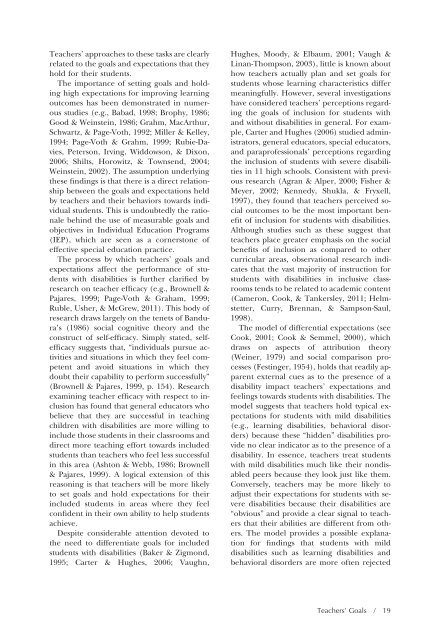etadd_48(1) - Division on Autism and Developmental Disabilities
etadd_48(1) - Division on Autism and Developmental Disabilities
etadd_48(1) - Division on Autism and Developmental Disabilities
You also want an ePaper? Increase the reach of your titles
YUMPU automatically turns print PDFs into web optimized ePapers that Google loves.
Teachers’ approaches to these tasks are clearly<br />
related to the goals <strong>and</strong> expectati<strong>on</strong>s that they<br />
hold for their students.<br />
The importance of setting goals <strong>and</strong> holding<br />
high expectati<strong>on</strong>s for improving learning<br />
outcomes has been dem<strong>on</strong>strated in numerous<br />
studies (e.g., Babad, 1998; Brophy, 1986;<br />
Good & Weinstein, 1986; Grahm, MacArthur,<br />
Schwartz, & Page-Voth, 1992; Miller & Kelley,<br />
1994; Page-Voth & Grahm, 1999; Rubie-Davies,<br />
Peters<strong>on</strong>, Irving, Widdows<strong>on</strong>, & Dix<strong>on</strong>,<br />
2006; Shilts, Horowitz, & Townsend, 2004;<br />
Weinstein, 2002). The assumpti<strong>on</strong> underlying<br />
these findings is that there is a direct relati<strong>on</strong>ship<br />
between the goals <strong>and</strong> expectati<strong>on</strong>s held<br />
by teachers <strong>and</strong> their behaviors towards individual<br />
students. This is undoubtedly the rati<strong>on</strong>ale<br />
behind the use of measurable goals <strong>and</strong><br />
objectives in Individual Educati<strong>on</strong> Programs<br />
(IEP), which are seen as a cornerst<strong>on</strong>e of<br />
effective special educati<strong>on</strong> practice.<br />
The process by which teachers’ goals <strong>and</strong><br />
expectati<strong>on</strong>s affect the performance of students<br />
with disabilities is further clarified by<br />
research <strong>on</strong> teacher efficacy (e.g., Brownell &<br />
Pajares, 1999; Page-Voth & Graham, 1999;<br />
Ruble, Usher, & McGrew, 2011). This body of<br />
research draws largely <strong>on</strong> the tenets of B<strong>and</strong>ura’s<br />
(1986) social cognitive theory <strong>and</strong> the<br />
c<strong>on</strong>struct of self-efficacy. Simply stated, selfefficacy<br />
suggests that, “individuals pursue activities<br />
<strong>and</strong> situati<strong>on</strong>s in which they feel competent<br />
<strong>and</strong> avoid situati<strong>on</strong>s in which they<br />
doubt their capability to perform successfully”<br />
(Brownell & Pajares, 1999, p. 154). Research<br />
examining teacher efficacy with respect to inclusi<strong>on</strong><br />
has found that general educators who<br />
believe that they are successful in teaching<br />
children with disabilities are more willing to<br />
include those students in their classrooms <strong>and</strong><br />
direct more teaching effort towards included<br />
students than teachers who feel less successful<br />
in this area (Asht<strong>on</strong> & Webb, 1986; Brownell<br />
& Pajares, 1999). A logical extensi<strong>on</strong> of this<br />
reas<strong>on</strong>ing is that teachers will be more likely<br />
to set goals <strong>and</strong> hold expectati<strong>on</strong>s for their<br />
included students in areas where they feel<br />
c<strong>on</strong>fident in their own ability to help students<br />
achieve.<br />
Despite c<strong>on</strong>siderable attenti<strong>on</strong> devoted to<br />
the need to differentiate goals for included<br />
students with disabilities (Baker & Zigm<strong>on</strong>d,<br />
1995; Carter & Hughes, 2006; Vaughn,<br />
Hughes, Moody, & Elbaum, 2001; Vaugh &<br />
Linan-Thomps<strong>on</strong>, 2003), little is known about<br />
how teachers actually plan <strong>and</strong> set goals for<br />
students whose learning characteristics differ<br />
meaningfully. However, several investigati<strong>on</strong>s<br />
have c<strong>on</strong>sidered teachers’ percepti<strong>on</strong>s regarding<br />
the goals of inclusi<strong>on</strong> for students with<br />
<strong>and</strong> without disabilities in general. For example,<br />
Carter <strong>and</strong> Hughes (2006) studied administrators,<br />
general educators, special educators,<br />
<strong>and</strong> paraprofessi<strong>on</strong>als’ percepti<strong>on</strong>s regarding<br />
the inclusi<strong>on</strong> of students with severe disabilities<br />
in 11 high schools. C<strong>on</strong>sistent with previous<br />
research (Agran & Alper, 2000; Fisher &<br />
Meyer, 2002; Kennedy, Shukla, & Fryxell,<br />
1997), they found that teachers perceived social<br />
outcomes to be the most important benefit<br />
of inclusi<strong>on</strong> for students with disabilities.<br />
Although studies such as these suggest that<br />
teachers place greater emphasis <strong>on</strong> the social<br />
benefits of inclusi<strong>on</strong> as compared to other<br />
curricular areas, observati<strong>on</strong>al research indicates<br />
that the vast majority of instructi<strong>on</strong> for<br />
students with disabilities in inclusive classrooms<br />
tends to be related to academic c<strong>on</strong>tent<br />
(Camer<strong>on</strong>, Cook, & Tankersley, 2011; Helmstetter,<br />
Curry, Brennan, & Samps<strong>on</strong>-Saul,<br />
1998).<br />
The model of differential expectati<strong>on</strong>s (see<br />
Cook, 2001; Cook & Semmel, 2000), which<br />
draws <strong>on</strong> aspects of attributi<strong>on</strong> theory<br />
(Weiner, 1979) <strong>and</strong> social comparis<strong>on</strong> processes<br />
(Festinger, 1954), holds that readily apparent<br />
external cues as to the presence of a<br />
disability impact teachers’ expectati<strong>on</strong>s <strong>and</strong><br />
feelings towards students with disabilities. The<br />
model suggests that teachers hold typical expectati<strong>on</strong>s<br />
for students with mild disabilities<br />
(e.g., learning disabilities, behavioral disorders)<br />
because these “hidden” disabilities provide<br />
no clear indicator as to the presence of a<br />
disability. In essence, teachers treat students<br />
with mild disabilities much like their n<strong>on</strong>disabled<br />
peers because they look just like them.<br />
C<strong>on</strong>versely, teachers may be more likely to<br />
adjust their expectati<strong>on</strong>s for students with severe<br />
disabilities because their disabilities are<br />
“obvious” <strong>and</strong> provide a clear signal to teachers<br />
that their abilities are different from others.<br />
The model provides a possible explanati<strong>on</strong><br />
for findings that students with mild<br />
disabilities such as learning disabilities <strong>and</strong><br />
behavioral disorders are more often rejected<br />
Teachers’ Goals / 19
















